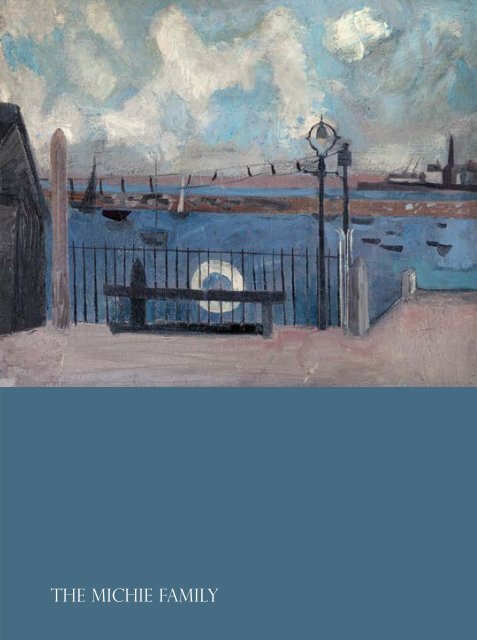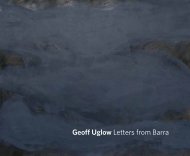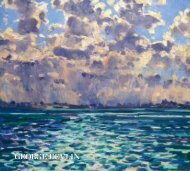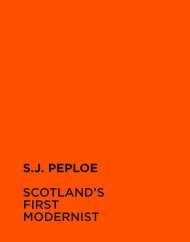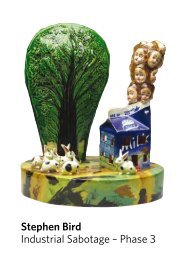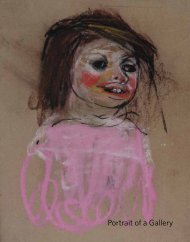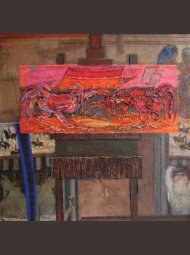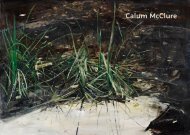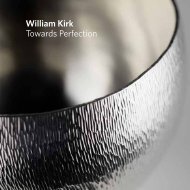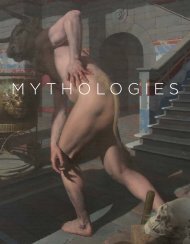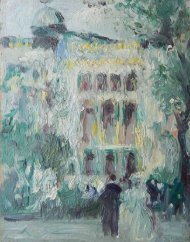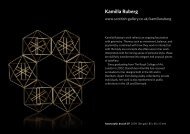Download a PDF of the exhibition catalogue - The Scottish Gallery
Download a PDF of the exhibition catalogue - The Scottish Gallery
Download a PDF of the exhibition catalogue - The Scottish Gallery
Create successful ePaper yourself
Turn your PDF publications into a flip-book with our unique Google optimized e-Paper software.
THE MICHIE FAMILY
THE MICHIE FAMILY<br />
4 – 30 JUNE 2012<br />
16 Dundas Street, Edinburgh EH3 6HZ<br />
Tel 0131 558 1200 Email mail@scottish-gallery.co.uk<br />
Web www.scottish-gallery.co.uk<br />
Front cover: David Michie, At <strong>the</strong> Harbour, Granton, 1953, oil on canvas, 56 x 69 cms<br />
Inside covers: James Michie, Bristol Construction Site, 1955, pencil, 66 x 85 cms
foreword<br />
It is not uncommon for some artistic talent to pass onto <strong>the</strong> next generation and for a number <strong>of</strong> siblings and children<br />
to pursue a similar creative pathway. Anne Redpath is recognized as one <strong>of</strong> <strong>the</strong> greatest painters <strong>of</strong> her generation; her<br />
reputation grew beyond <strong>the</strong> confines <strong>of</strong> Scotland in her lifetime and continues to grow. Two <strong>of</strong> her sons, David and Alastair<br />
have pursued careers in painting, although quite separately. <strong>The</strong>y both used <strong>the</strong>ir own family name, Michie, that came<br />
from <strong>the</strong>ir fa<strong>the</strong>r James and for many it will be his group <strong>of</strong> paintings which provides <strong>the</strong> surprise in this family <strong>exhibition</strong>.<br />
He was an architect/peintre who perhaps suffered as a painter because <strong>of</strong> his chosen pr<strong>of</strong>ession as an architect. Architecture<br />
has long been accepted as a pillar equal to painting in <strong>the</strong> academies <strong>of</strong> <strong>the</strong> arts but pr<strong>of</strong>essional duties and affiliations put a<br />
restraint on <strong>the</strong> architect’s ability to be accepted as a painter beyond <strong>the</strong> expectation <strong>of</strong> competence. For James Michie <strong>the</strong><br />
burgeoning talent <strong>of</strong> his wife may have put a fur<strong>the</strong>r barrier in <strong>the</strong> way <strong>of</strong> a full flowering <strong>of</strong> his own ability. Diffidence, a lack<br />
<strong>of</strong> hard work, jealousies and an absence <strong>of</strong> self-belief have undermined many potentially successful careers and sometimes<br />
<strong>the</strong> furnace <strong>of</strong> one man’s genius can consume <strong>the</strong> lesser abilities <strong>of</strong> his immediate family. For <strong>the</strong> Michie boys painting was<br />
not a family business (in <strong>the</strong> sense <strong>of</strong> <strong>the</strong> Renaissance family atelier) but two individuals combining natural talents with<br />
a steely determination to pursue <strong>the</strong>ir own star. For Lindsay, <strong>the</strong> middle son, different, practical gifts launched him on a<br />
business career with GEC which many would consider as equally ‘successful’ as <strong>the</strong> mercurial Alastair or David, prospering<br />
at Edinburgh College <strong>of</strong> Art. Some will look at this <strong>exhibition</strong> and see family likenesses in approach to painting. All will have<br />
a glimpse <strong>of</strong> family life, with <strong>the</strong> inclusion <strong>of</strong> one piece <strong>of</strong> Redpath-adorned furniture, and truly <strong>the</strong>ir mo<strong>the</strong>r’s personality<br />
expressed large in her work and her home must have been somehow formative on <strong>the</strong> children.<br />
Guy Peploe<br />
Lindsay, David and Alastair at Eyemouth c.1940; Michie boys and<br />
friends at Chateau Gloria c.1932; Anne in St Omer 1921; Alastair;<br />
James in Uniform c.1914; David; Anne at Edinburgh College <strong>of</strong><br />
Art c.1915; Anne Redpath<br />
2
James Beattie Michie<br />
(1891–1960)<br />
Though born in Inverness, James Michie was from a family firmly based in Hawick. He attended school <strong>the</strong>re, and <strong>the</strong>reafter<br />
was apprenticed to an architectural practice, Alan Hopkirk, in that town. My fa<strong>the</strong>r joined <strong>the</strong> army in 1914 when war broke<br />
out and served in <strong>the</strong> Royal Scots Regiment. Several years were spent on <strong>the</strong> Western Front, and he was <strong>the</strong>n despatched to<br />
India, serving in <strong>the</strong> 54th Sikh Regiment.<br />
Married in 1920 to Anne Redpath, he was apprenticed that year to <strong>the</strong> War Graves Commission, and joined o<strong>the</strong>r,<br />
mainly young, architects under <strong>the</strong> direction <strong>of</strong> Edwin Lutyens, tasked in <strong>the</strong> design and layout <strong>of</strong> <strong>the</strong> many war cemeteries,<br />
big and small, that were spread about in <strong>the</strong> north-east corner <strong>of</strong> France. My fa<strong>the</strong>r’s interest in painting can be seen<br />
developing at that time, and <strong>the</strong> landscape, <strong>of</strong>ten featuring a windmill, became a subject <strong>of</strong> attraction. An interest in painting<br />
remained throughout his life. This was not particularly unusual for an architect. Charles Rennie Mackintosh and o<strong>the</strong>rs have<br />
shown much skill and achievement in painting.<br />
Moving to <strong>the</strong> south <strong>of</strong> France in <strong>the</strong> late 20’s, my fa<strong>the</strong>r became a private architect to a wealthy American, Charles<br />
Thompson, who had bought a large villa, he named Chateau Gloria, at St Jean on Cap Ferrat, adjacent to Villefranche.<br />
He carried out a number <strong>of</strong> projects – a loggia, a swimming pool in <strong>the</strong> large garden <strong>of</strong> <strong>the</strong> estate, and o<strong>the</strong>r projects within<br />
<strong>the</strong> chateau. In 1931 he was commissioned to paint two murals in <strong>the</strong> Chapelle St Roseline at a Carthusian Monastery,<br />
Chartreuse Notre-Dame de Montrieux, situated in wooded country about 30 kilometres north <strong>of</strong> Toulon.<br />
Thompson lost much <strong>of</strong> his wealth during <strong>the</strong> years following <strong>the</strong> 1929 crash and in 1934 he sold <strong>the</strong> chateau,<br />
returning to America, and <strong>the</strong> Michie family moved back to Hawick. Employment prospects at this time were bleak, but<br />
my fa<strong>the</strong>r was fortunate to be appointed to a prominent architecture practice, Charles Holden and Partners, in London.<br />
When war broke out in 1939, he volunteered to join <strong>the</strong> army and was placed in <strong>the</strong> Gloucestershire Regiment and, no doubt<br />
because <strong>of</strong> his <strong>Scottish</strong> background, was appointed as requisitioning <strong>of</strong>ficer for <strong>the</strong> Borders. He spent <strong>the</strong> war years based<br />
in Galashiels, attending to <strong>the</strong> needs <strong>of</strong> <strong>the</strong> thousands <strong>of</strong> soldiers who required billeting in <strong>the</strong> Borders region. He had time<br />
to make paintings, surprisingly. After <strong>the</strong> war he was appointed as a lecturer at <strong>the</strong> West <strong>of</strong> England School <strong>of</strong> Architecture<br />
in Bristol. He balanced his time teaching architecture to his students and making paintings, and held <strong>exhibition</strong>s <strong>the</strong>re.<br />
It was a varied life with different experiences. Making paintings was a constant thread.<br />
David Michie<br />
April 2012<br />
4
Borders Landscape, c.1944<br />
watercolour on paper laid on board, 44 x 53 cms<br />
5
Landscape, Nor<strong>the</strong>rn France<br />
oil on canvas, 43 x 58 cms<br />
6
Bristol Construction Site, 1955<br />
pencil, 66 x 85 cms<br />
7
Two Figures<br />
oil on canvas, 61 x 61 cms<br />
8
Still Life with Chinese Figures<br />
oil on canvas, 64 x 73 cms<br />
9
anne redpath<br />
(1895–1965) OBE, RSA, ARA, RWA<br />
Anne Redpath was born on <strong>the</strong> 29th <strong>of</strong> March, 1895 in Galashiels in <strong>the</strong> heart <strong>of</strong> <strong>the</strong> <strong>Scottish</strong> Borders. Her fa<strong>the</strong>r Thomas<br />
Redpath was a celebrated tweed designer who was recognised both as an innovator and exceptional colourist. It was not just<br />
an eye for colour that Anne inherited from her fa<strong>the</strong>r, but a focus and pr<strong>of</strong>essionalism to her craft which was to drive her<br />
throughout her life. One <strong>of</strong> four children, Anne attended Hawick High School where her artistic talent was spotted by <strong>the</strong><br />
art teacher John Gray (later to be president <strong>of</strong> <strong>the</strong> Royal Society for Painters in Watercolour).<br />
Anne arrived at Edinburgh College <strong>of</strong> Art in 1913, although she had to simultaneously attend a teacher training<br />
course at Moray House to keep her fa<strong>the</strong>r happy. Graduating with a diploma in 1918, she was also awarded a year’s postgraduate<br />
study followed by a travelling scholarship <strong>the</strong> following year. She visited Brussels, Bruges, Paris, Florence and most<br />
importantly, Sienna. Her encounter with <strong>the</strong> Siennese Primitives was to impress her greatly. It was <strong>the</strong>ir simplification <strong>of</strong><br />
form partnered with a powerful vision that had most resonance with her, and <strong>the</strong>ir influence is seen in her landscapes <strong>of</strong> <strong>the</strong><br />
1920s and 30s as well as work from <strong>the</strong> end <strong>of</strong> her life. On her return from her travels Anne was engaged to James Michie,<br />
a young architect also from <strong>the</strong> Borders. <strong>The</strong>y married in 1920 and almost immediately moved to St Omer in Nor<strong>the</strong>rn<br />
France, where James was working for <strong>the</strong> War Graves Commission. It was in St Omer where <strong>the</strong> first two Michie sons were<br />
born. She did have a small <strong>exhibition</strong> in St Omer in 1921 (and again in St. Raphael in 1928) but at this stage Anne’s painting<br />
took a back seat, her priorities were with her young family. <strong>The</strong>y had moved again at this point to St. Jean, Cap Ferrat near<br />
Nice. Although painting was not her first priority at this time, her drive as an artist was by no means diminished. In her own<br />
words:<br />
‘Young women <strong>of</strong>ten come up to me and say: “I am going to be like you and give up everything for painting”, but<br />
that’s not how I see it at all. I could never have sacrificed my family to painting, and I don’t think anyone else should ei<strong>the</strong>r…<br />
I put everything I had into house and furniture and dresses and good food and people. All that’s <strong>the</strong> same sort <strong>of</strong> thing as<br />
painting really, and <strong>the</strong> experience went back into art when I began painting again.’<br />
When she returned to Hawick in 1934 <strong>the</strong> landscape <strong>of</strong> her childhood <strong>of</strong>fered much inspiration; winter light,<br />
bare trees and swollen rivers <strong>of</strong> <strong>The</strong> Borders. In her studio she painted a few memorable figure compositions including<br />
touching family portraits, three <strong>of</strong> which feature in this <strong>exhibition</strong>. Increasingly, tabletop still lifes became a favourite subject<br />
and were to make her reputation, (and as James had moved to London in search <strong>of</strong> work) her livelihood. Her palette during<br />
<strong>the</strong> 1930s was at first muted and <strong>the</strong>re is both a delicacy in application and mastery <strong>of</strong> pale tones and areas <strong>of</strong> jewel-like<br />
colour. Her landscapes, painted in <strong>the</strong> studio are a distillation <strong>of</strong> experience; her choice <strong>of</strong> what to include and exclude in<br />
her design part <strong>of</strong> her character as a picture maker.<br />
In <strong>the</strong> 1950s and until her death in 1965 she travelled extensively (<strong>of</strong>ten with her sons in tow!), which hugely<br />
enriched <strong>the</strong> scope <strong>of</strong> her subject matter. She always brought back exotic objects for <strong>the</strong> studio and sketchbooks full <strong>of</strong><br />
material for her oils. Her first trip back to <strong>the</strong> continent was in 1949, and again in 1950. She travelled to Spain in <strong>the</strong> spring<br />
<strong>of</strong> 1951 with her friend Bill Garrad. <strong>The</strong> harsh landscape and stark light <strong>of</strong> <strong>the</strong> Spanish countryside astounded her, and was<br />
very different from <strong>the</strong> warm, gentleness <strong>of</strong> <strong>the</strong> South <strong>of</strong> France. It engendered a change which was to affect her practice<br />
for <strong>the</strong> last years <strong>of</strong> her life;<br />
‘If one painted nothing but still-life one would fall into <strong>the</strong> narrow range <strong>of</strong> one’s own natural selection. To go to<br />
Spain and find dark grey skies and white villages; to Italy and find that <strong>the</strong> sky is more violet than blue; to Corsica and find<br />
violets and scarlets on <strong>the</strong> hillsides; all this enlarges one’s range <strong>of</strong> colour and responsiveness.’<br />
10
Like most <strong>of</strong> <strong>the</strong> edinburgh School painters she divided her output between oil and working on paper, valuing each<br />
<strong>the</strong> same. Latterly in her flowers, townscapes and church interiors her treatment <strong>of</strong> <strong>the</strong> canvas became more abstract as she<br />
abandoned traditional spatial composition. Her technique developed also, employing <strong>the</strong> palette knife as much as <strong>the</strong> brush<br />
and using rich and brilliant colour.<br />
redpath was an inspirational person and formed many enduring friendships. Her flat in London Street became an<br />
artistic salon, immortalised by robin Philipson’s affectionate group portrait now in <strong>The</strong> <strong>Scottish</strong> National Portrait <strong>Gallery</strong>.<br />
Since her death her reputation has been fur<strong>the</strong>r enhanced with retrospectives including an <strong>exhibition</strong> at <strong>The</strong> <strong>Scottish</strong><br />
National <strong>Gallery</strong> <strong>of</strong> Modern Art in 1996. She was a woman devoted to her family as well as her art. This <strong>exhibition</strong> features<br />
early Borders landscapes, sparse and immediate, as well as later works: still lifes rich in colour and texture reminding us <strong>of</strong><br />
<strong>the</strong> breadth <strong>of</strong> her artistic ability. <strong>The</strong>re is youthful sense <strong>of</strong> enquiry throughout her work and a delight in her subject matter<br />
which is individual and always vivacious.<br />
Portrait <strong>of</strong> David as a baby<br />
pastel on paper, 29 cms diameter<br />
11
<strong>The</strong> White Azalea<br />
oil on canvas, 51 x 76 cms<br />
12
Menton<br />
gouache, 53 x 38 cms<br />
13
Spring Trees<br />
gouache, 35 x 48 cms<br />
14
Borders River<br />
gouache, 35.5 x 50.5 cms<br />
15
Corsican Village<br />
lithograph, 22 x 30 cms<br />
16
Church from <strong>the</strong> Window<br />
pen & watercolour, 50 x 40 cms<br />
17
Jug with Fruit (blue & red)<br />
lithograph, 28 x 45 cms<br />
18
Flowers in a Teapot<br />
ink & watercolour, 24.5 x 32.5 cms<br />
19
Summer Flowers in a Green Vase<br />
oil, 46 x 35.5 cms<br />
20
White Geraniums, 1962<br />
oil on board, 51 x 61 cms<br />
21
Street in Menton – A Spanish Street<br />
gouache, 37 x 45.5 cms<br />
22
<strong>The</strong> Angel Gabriel from <strong>the</strong> Chapel <strong>of</strong> St Jean, Treboul<br />
gouache, 36 x 27.5 cms<br />
23
Alastair Michie<br />
(1921–2008) RWA, FRBS<br />
<strong>The</strong> oldest <strong>of</strong> <strong>the</strong> Michie boys Alastair was born in St. Omer, France in 1921 attending French schools until <strong>the</strong> age <strong>of</strong> 12.<br />
When <strong>the</strong> family moved back to <strong>the</strong> Borders he continued his schooling in Hawick. After gaining a scholarship to Edinburgh<br />
College <strong>of</strong> Art he followed in his fa<strong>the</strong>r’s footsteps and studied architecture. While at university he enlisted in <strong>the</strong> University<br />
Air Squadron and at <strong>the</strong> outbreak <strong>of</strong> War he travelled to Florida to begin his training. Miraculously Alastair survived <strong>the</strong><br />
War having served with distinction as a night fighter pilot over German lines. When <strong>the</strong> War ended he was reluctant to<br />
return to ano<strong>the</strong>r three years <strong>of</strong> study and decided to apply his talent as a draughtsman to <strong>the</strong> art <strong>of</strong> illustration. He became<br />
an extremely successful fashion illustrator and designer, eventually gaining international recognition. It was at this stage that<br />
Alastair moved from London to Wareham in Dorset, where he would remain for <strong>the</strong> rest <strong>of</strong> his life.<br />
In 1963 Alastair and his mo<strong>the</strong>r made a trip to Venice which was to dramatically change his direction as an artist.<br />
At <strong>the</strong> Biennale he saw firsthand <strong>the</strong> abstract expressionist works brought over from New York. <strong>The</strong> sheer scale and energy <strong>of</strong><br />
Mark Rothko, Franz Kline and Robert Mo<strong>the</strong>rwell were critical in his decision to become a painter and elicited a desire to<br />
paint in a way that <strong>the</strong> example set by his mo<strong>the</strong>r had not. Alastair met Mark Rothko after his friend John Plumb’s <strong>exhibition</strong><br />
opening at <strong>the</strong> Axiom <strong>Gallery</strong> in London a few years later. It was an encounter that confirmed his belief that abstraction was<br />
a vehicle for universal human emotion. Although now into his 40s this experience engendered a drastic change in his artistic<br />
direction and triggered a desire to become a painter full time (much to <strong>the</strong> surprise <strong>of</strong> his family!). Alastair always distanced<br />
himself from his mo<strong>the</strong>r’s influence, proclaiming: “my mo<strong>the</strong>r’s work did not influence me”. However it is not farfetched to<br />
see, Anne Redpath’s feeling for colour and texture is evident in her son’s mature work.<br />
Alastair’s work whe<strong>the</strong>r painting or sculpture was always influenced by his own experience and environment.<br />
His work in both disciplines was always closely linked to <strong>the</strong> landscape and Jurassic coastline <strong>of</strong> his beloved Dorset. Images<br />
<strong>of</strong> land and sea viewed from above inspired him and his work Target from 2004, shows clearly <strong>the</strong> influence <strong>of</strong> his wartime<br />
experiences. Local beaches also proved to be a rich source <strong>of</strong> inspiration. On a first trip to Studland beach he discovered<br />
jagged pieces <strong>of</strong> metal, shrapnel and unexploded shells which were to inspire his striking series <strong>of</strong> sculptures he called<br />
Shrapnel. Endeavour, a 15 foot bronze commissioned by British Aerospace in Bristol is a mixture <strong>of</strong> organic and mechanic<br />
form: its dynamic shape evokes <strong>the</strong> striking silhouette <strong>of</strong> a fighter’s tailplane. A smaller version is available in this <strong>exhibition</strong>.<br />
Since ideas <strong>of</strong> structure and design ran parallel with more evocative and poetic ideas in his work, Alastair’s decision<br />
to sculpt seemed a natural progression. However it is for painting that Alastair is better known. His first <strong>exhibition</strong> was<br />
put on in Edinburgh’s Traverse <strong>The</strong>atre in 1964 and featured richly coloured and textured acrylics (see Ammonite opposite)<br />
related to <strong>the</strong> American painters he admired. He enjoyed a major solo <strong>exhibition</strong> in Sao Paulo, Brazil in 1972 and <strong>the</strong> art<br />
museums both in Sao Paulo and Rio acquired his work for <strong>the</strong>ir permanent collections. In 1979 <strong>the</strong>re was a major <strong>exhibition</strong><br />
<strong>of</strong> his sculpture at <strong>the</strong> Alwin <strong>Gallery</strong>, London.<br />
In 1982 he became a Royal West <strong>of</strong> England Academician and a fellow <strong>of</strong> <strong>the</strong> Royal Society <strong>of</strong> British Sculptors in<br />
1994. He enjoyed a solo <strong>exhibition</strong> at <strong>the</strong> Mall <strong>Gallery</strong> in 1996 and ano<strong>the</strong>r with Archeus Fine Art in 2000. In 2007 he was<br />
awarded an honorary doctorate from Bournemouth University.<br />
24
Ammonite, c.1962<br />
mixed media on canvas, 100 x 120 cms<br />
25
Cool, c.2006<br />
mixed media on canvas, 142 x 142 cms<br />
26
Endeavour, 1989<br />
bronze, edition 4/5, 20 cms height x 17 cms width<br />
African Head <strong>of</strong> a Girl, c.1960<br />
cast aluminium, edition 2/5, 19 cms height<br />
27
Fathom, c.1992<br />
acrylic on board, 56 x 102 cms<br />
28
Solo, c.2008<br />
acrylic on board, 50 x 60 cms<br />
29
Paper Roses, c.1987<br />
acrylic on board, 57 x 71 cms<br />
30
Margins XXI, c.2002<br />
acrylic on board, 90 x 70 cms<br />
31
Fishing Boats Chioggia, c. 1967<br />
mixed media on board, 24 x 21 cms<br />
32
Fashion Drawing I<br />
pastel, 53 x 30 cms<br />
Fashion Drawing II<br />
mixed media, 53 x 40 cms<br />
33
Fashion Drawing III<br />
mixed media, 46 x 40 cms<br />
Fashion Drawing IV<br />
mixed media, 49 x 40 cms<br />
Fashion Drawing VI<br />
mixed media, 39 x 33 cms<br />
Fashion Drawing VII<br />
mixed media, 54 x 39 cms<br />
34
Fashion Drawing XIII<br />
mixed media, 66 x 44 cms<br />
35
david Michie<br />
(b.1928) OBE, RSA, FRSA<br />
<strong>The</strong> youngest <strong>of</strong> <strong>the</strong> Michie boys, David was born in St. Raphael in 1928. He studied at Edinburgh College <strong>of</strong> Art from<br />
1947–53 under <strong>the</strong> painter, William Gillies. He was awarded a travelling scholarship upon graduating and travelled to Italy<br />
in 1953 with fellow painter and friend John Houston. On returning to Edinburgh he took up a post at <strong>the</strong> College <strong>of</strong> Art,<br />
becoming Head <strong>of</strong> Drawing and Painting from 1982–90.<br />
David’s first years immersed in <strong>the</strong> light and sun soaked landscape <strong>of</strong> <strong>the</strong> South <strong>of</strong> France were to have a lasting effect<br />
on him. Not only did it give him awareness <strong>of</strong> colour, but it gave him a taste for a life outside Scotland that was to inspire a<br />
love for travel he has kept throughout his life. On returning to Hawick at <strong>the</strong> age <strong>of</strong> eight he was placed in a landscape <strong>of</strong> a<br />
different sort, but <strong>the</strong> vistas <strong>of</strong> <strong>the</strong> Lammermuirs, fields and woods around Hawick did not fascinate him in <strong>the</strong> same way<br />
<strong>the</strong>y captured his mo<strong>the</strong>r. David’s gaze was more focused, enticed by <strong>the</strong> smaller aspects <strong>of</strong> <strong>the</strong> natural world; a dragon fly<br />
skimming across a pond’s surface.<br />
David’s lack <strong>of</strong> interest in conventional landscape painting led him to create a visual language completely unique.<br />
Not constricted by academic drawing, his compositions <strong>of</strong> flora and fauna are simplified in form and <strong>of</strong>ten float in an<br />
ambiguous space <strong>of</strong> flattened colour and pattern as in Seed Pods and Cosmos. <strong>The</strong> world that <strong>the</strong> artist describes is abundant<br />
and diverse and appeals directly to our senses. His figure subjects, (images <strong>of</strong>ten inspired by foreign travel) which can feature<br />
subjects as diverse as jazz musicians, skateboarders or fisherman, are all perfect snapshots <strong>of</strong> <strong>the</strong> bizarre natural drama <strong>of</strong><br />
human experience. His most recent works focus on <strong>the</strong> <strong>the</strong>me <strong>of</strong> Midnight Tango, and are made with <strong>the</strong> same wit, strong<br />
colour and harmonious design which David Michie has become renowned for.<br />
David followed in his mo<strong>the</strong>r’s footsteps choosing to live in Edinburgh and become a prominent member <strong>of</strong> <strong>the</strong><br />
second generation <strong>of</strong> <strong>The</strong> Edinburgh School. Along with his friends and contemporaries Elizabeth Blackadder and John<br />
Houston, Michie’s contribution to <strong>Scottish</strong> painting is as an original image maker but also as a painter who believes in<br />
painting; a serious pursuit but one also which can give great pleasure.<br />
<strong>The</strong> 17 works in this <strong>exhibition</strong> <strong>of</strong>fers a modest review <strong>of</strong> David’s career and includes two early Edinburgh cityscapes;<br />
letting us wonder again at <strong>the</strong> originality <strong>of</strong> <strong>the</strong> artist and see <strong>the</strong> world though his eyes.<br />
He is an elected member <strong>of</strong> <strong>the</strong> Royal <strong>Scottish</strong> Academy, <strong>The</strong> Royal Glasgow Institute and past President <strong>of</strong> <strong>the</strong><br />
Society <strong>of</strong> <strong>Scottish</strong> Artists. He was awarded an OBE in 1997. His paintings are held in <strong>the</strong> collection <strong>of</strong> H.M. <strong>The</strong> Queen,<br />
<strong>The</strong> <strong>Scottish</strong> Arts Council, <strong>The</strong> <strong>Scottish</strong> National <strong>Gallery</strong> <strong>of</strong> Modern Art and o<strong>the</strong>r major public collections <strong>of</strong> <strong>Scottish</strong> art.<br />
36
At <strong>the</strong> Harbour, Granton, 1953<br />
oil on canvas, 56 x 69 cms<br />
37
By <strong>the</strong> Bridge, Leith, 1953<br />
oil on canvas, 69 x 56 cms<br />
38
Rosemount Building, Gardners Crescent, 1964<br />
oil on canvas, 86 x 112 cms<br />
39
Skunk Cabbage Flowers – Arduaine, 1986<br />
oil on canvas, 91.5 x 127 cms<br />
40
Convolvulus Hawkmoth at a Flower, 1995<br />
oil on canvas, 38 x 38 cms<br />
41
Seed Pods and Cosmos, 2010<br />
oil on canvas, 86 x 86 cms<br />
42
Damsel Fly on a Leaf, 1995<br />
oil on canvas, 38 x 38 cms<br />
43
Trumpet Player at Cork, 1996<br />
oil on canvas, 38 x 38 cms<br />
44
George Melly at <strong>the</strong> Festival <strong>The</strong>atre, 1998<br />
oil on canvas, 38 x 38 cms<br />
45
Bending over Backwards, 2011<br />
oil on board, 20 x 20 cms<br />
Brief Encounter, 2011<br />
oil on board, 20 x 20 cms<br />
46
Dancing in <strong>the</strong> Bar Room, 2011<br />
oil on board, 20 x 20 cms<br />
Kicking Out, 2011<br />
oil on board, 20 x 20 cms<br />
47
Published by <strong>The</strong> <strong>Scottish</strong> <strong>Gallery</strong> to coincide with <strong>the</strong> <strong>exhibition</strong><br />
<strong>the</strong> MICHIE FAMILY<br />
4 – 30 JUNE 2012<br />
Exhibition can be viewed online at www.scottish-gallery.co.uk/<strong>the</strong>michiefamily<br />
Our warm thanks to all <strong>the</strong> Michie family for making <strong>the</strong> <strong>exhibition</strong> possible.<br />
ISBN 978-1-905146-67-3<br />
Designed by www.kennethgray.co.uk<br />
Photography by William Van Esland Photography<br />
Printed by J Thomson Colour Printers<br />
All rights reserved. No part <strong>of</strong> this <strong>catalogue</strong> may be reproduced in any form by<br />
print, photocopy or by any o<strong>the</strong>r means, without <strong>the</strong> permission <strong>of</strong> <strong>the</strong> copyright<br />
holders and <strong>of</strong> <strong>the</strong> publishers.<br />
16 Dundas Street, Edinburgh EH3 6HZ<br />
Tel 0131 558 1200 Email mail@scottish-gallery.co.uk<br />
Web www.scottish-gallery.co.uk<br />
Back cover: Anne Redpath, Borders Landscape, gouache, 51 x 35.5 cms<br />
48


